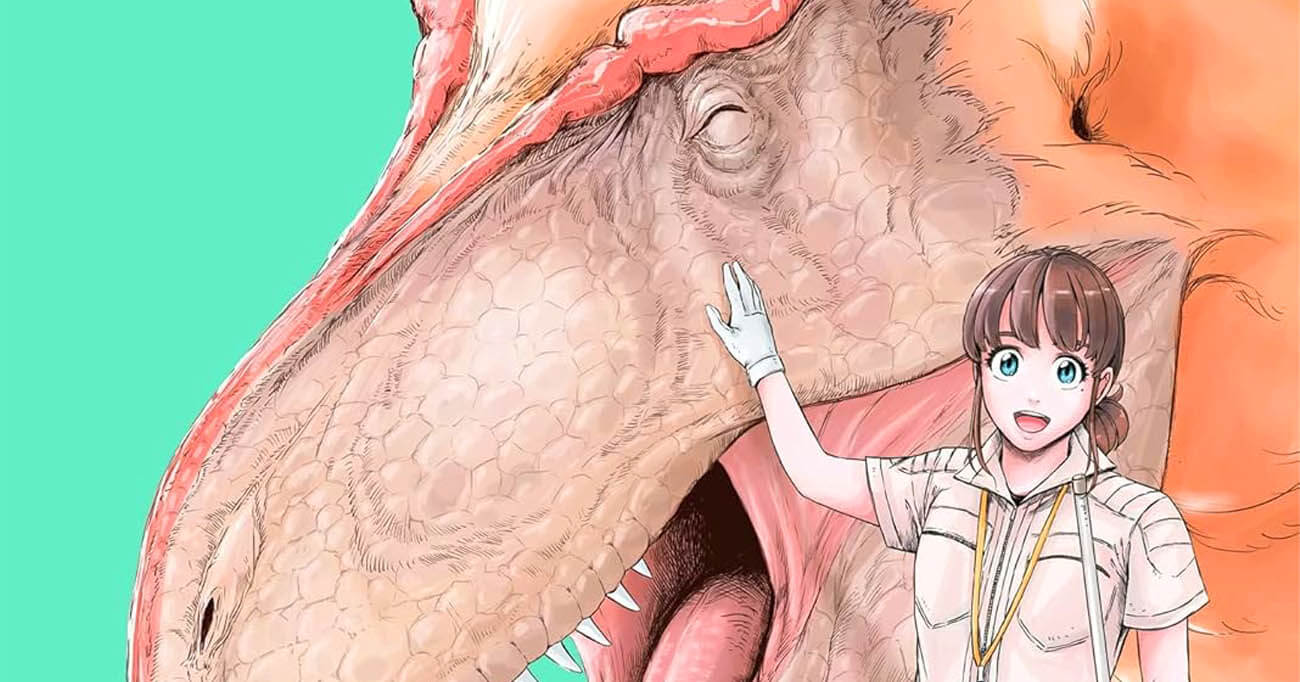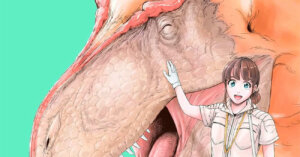Most stories about dinosaurs interacting with people don’t end well. Often, they’re concerned with mankind’s hubris and how scientific ambition trumps ecological benevolence. Either that, or they’re dedicated to displaying what happens when soft, fleshy dudes come in contact with mountains of scales and claws. Sometimes, they’re about both! But Dinosaur Sanctuary, the manga by author Itaru Kinoshita (with research work by Nagoya University Museum lecturer Shin-Ichi Fujiwara) opts for something a bit more uplifting and even humanizing at times.
The manga, which was nominated for Best Continuing Manga Series at the inaugural American Manga Awards this year, takes place in a world well-accustomed to the fact that dinosaurs and other prehistoric creatures exist. After discovering an island full of them in the 1940s, “careful breeding and genetic manipulation” made them into the subjects of multiple modern zoos around the world. Dinosaur Sanctuary follows one of these zoos, “Enoshima DinoLand,” and the folks that work there, from excitable newbie Suma Suzume to by-the-books theropod caretaker Kaidou Arata.
It’s Not Quite Like Jurassic Park
You’re not alone if you think this sounds like a riff on Jurassic Park, one of the most famous blockbuster franchises in the history of cinema. But Dinosaur Sanctuary goes far beyond “What if Jurassic Park was friendlier?” Jurassic Park presents its parade of creatures as forces of nature. Even when some become mainstays of the ongoing story, like Chris Pratt’s beloved Velociraptor Blue, we never get to know them. And that’s part of the point of Jurassic Park – they are inherently unknowable. It is foolish for scientists and industrialists to think that they have such control over ancient reptiles that they can truly manage their existences.
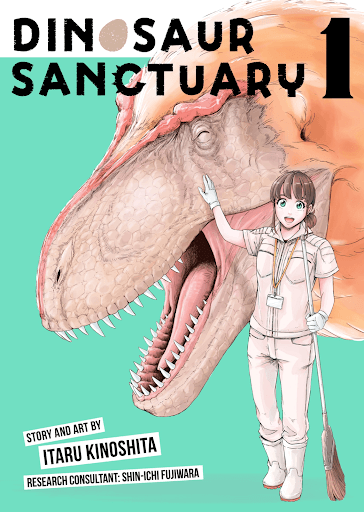
Dinosaur Sanctuary, on the other hand, suggests that perhaps we can deal with dinosaurs on a deeper level than just awe (or terror). It’s summed up best in Chapter 12, when the park’s staff engages in a brainstorming session to figure out new ways to draw in visitors. Suzume offers up the idea that they should add personal touches, like a live video feed to show off the dinosaurs when they’re just hanging out. “If people see how dinos really are, even at their weakest,” Suzume explains, “they’ll see themselves in them and come to love them.”
Even The Dinosaurs Have Personality
Dinosaur Sanctuary never anthropomorphizes the creatures, even if chapters often end with dinosaurs in an adorable state of contentedness. But Kinoshita’s narrative does aim for what Suzume hopes to bring to the exhibits: an empathetic identity for each dinosaur. The most notable example is Hanako, an aging female Tyrannosaurus who is far from the nightmare spectacle of her pop culture peers. Instead, she’s gentle, tired, and content to relax and be celebrated with a birthday party. It’s a marked contrast from Hachibei, an injury-prone Pachycephalosaurus still adjusting to the death of his former mate and is experiencing what can be best described as “dino angst.”
Others range from an attention-seeking Spinosaurus to a feisty Troodon. But it all amounts to granting personal stakes to the story outside of human drama. Much of the plot revolves around the park staff’s attempts to revitalize their declining attendance or care for the dinosaurs themselves. By giving the animals noticeable traits and quirks, we find emotional poignancy that otherwise would not be present. Far from being “cold-blooded,” the dinosaurs seek connections and comforts of their own. And so the reader comes to embrace them as far more than just theme park fodder.
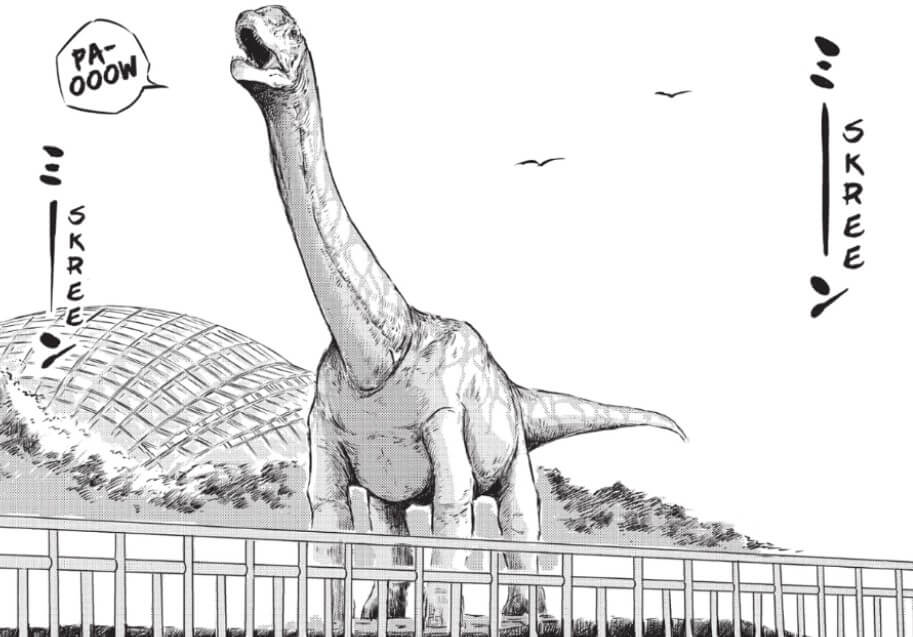
It’s A Remarkably Gentle Read
One aspect that shines in Dinosaur Sanctuary, especially if you’ve grown up adoring all things prehistoric, is the optimism of the characters. You’re unlikely to find any examples of ground-breaking emotional arcs, so focused as many of the park employees are on making dinosaur lives better and improving ticket sales. But their growth and how they come to tend and feel protective over the dinosaurs in their own ways can be delightful. Everyone that was raised as a “dinosaur kid” had their own favorites and their singular method of envisioning the Mesozoic era. So there’s a measure of relatability in the underdog tale of DinoLand’s employees
It’s a breezy read, even with Fujiwara contributing detailed yet accessible essays about dinosaurs, biology and scientific academia between each chapter. Though there are moments that take a darker turn (Arata’s backstory is a surprisingly tragic outlier), much of Dinosaur Sanctuary thrives on kindness. There’s little in the way of morbidity or violence, and tension comes from against-the-clock efforts in providing the best possible help to a dinosaur in need. If you’re looking for a Jurassic Park-style thrill ride, you may either find Dinosaur Sanctuary refreshing or too low-key.
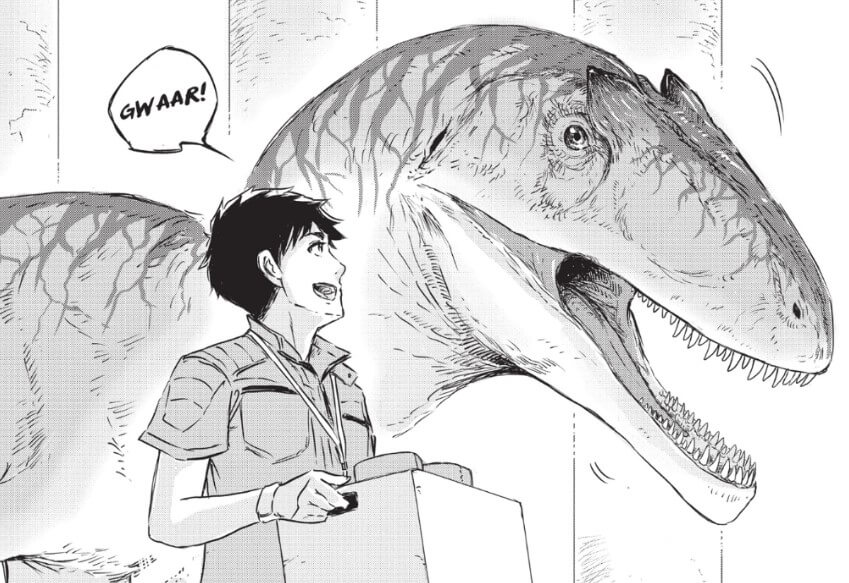
Dinosaur Sanctuary has only had four volumes released in the US, with a fifth volume set to debut on September 17th 2024. I hope it gets many more thanks to its quiet revolution of the typical dinosaur narrative. Rather than rollercoaster, event-style storytelling where people are around to either be eaten or try not to be eaten, Dinosaur Sanctuary is pure slice-of-life. It lets readers fall into the rhythm of what it might be like to work at a dinosaur zoo with all of the little triumphs and episodes of tedium that a job like that might entail. And, just as importantly, it lets readers learn what it might feel like to live in a dinosaur zoo, albeit one with a staff that actually cares and isn’t driven by ridiculous corporate profiteering. Have you ever seen yourself in an elderly Tyrannosaurus? Well, now is the time.
You can purchase Dinosaur Sanctuary on Bookshop, Amazon, and Barnes & Noble. Read more about this series on Seven Seas Entertainment.

Featured Sponsor - JAST
The sweetest romance and the darkest corruption, the biggest titles and the indie darlings; for visual novels and eroge, there's nowhere better.
Big thank you to our supporters
From their continous support, we are able to pay our team for their time and hard work on the site.
We have a Thank-You page dedicated to those who help us continue the work that we’ve been doing.
See our thank you page